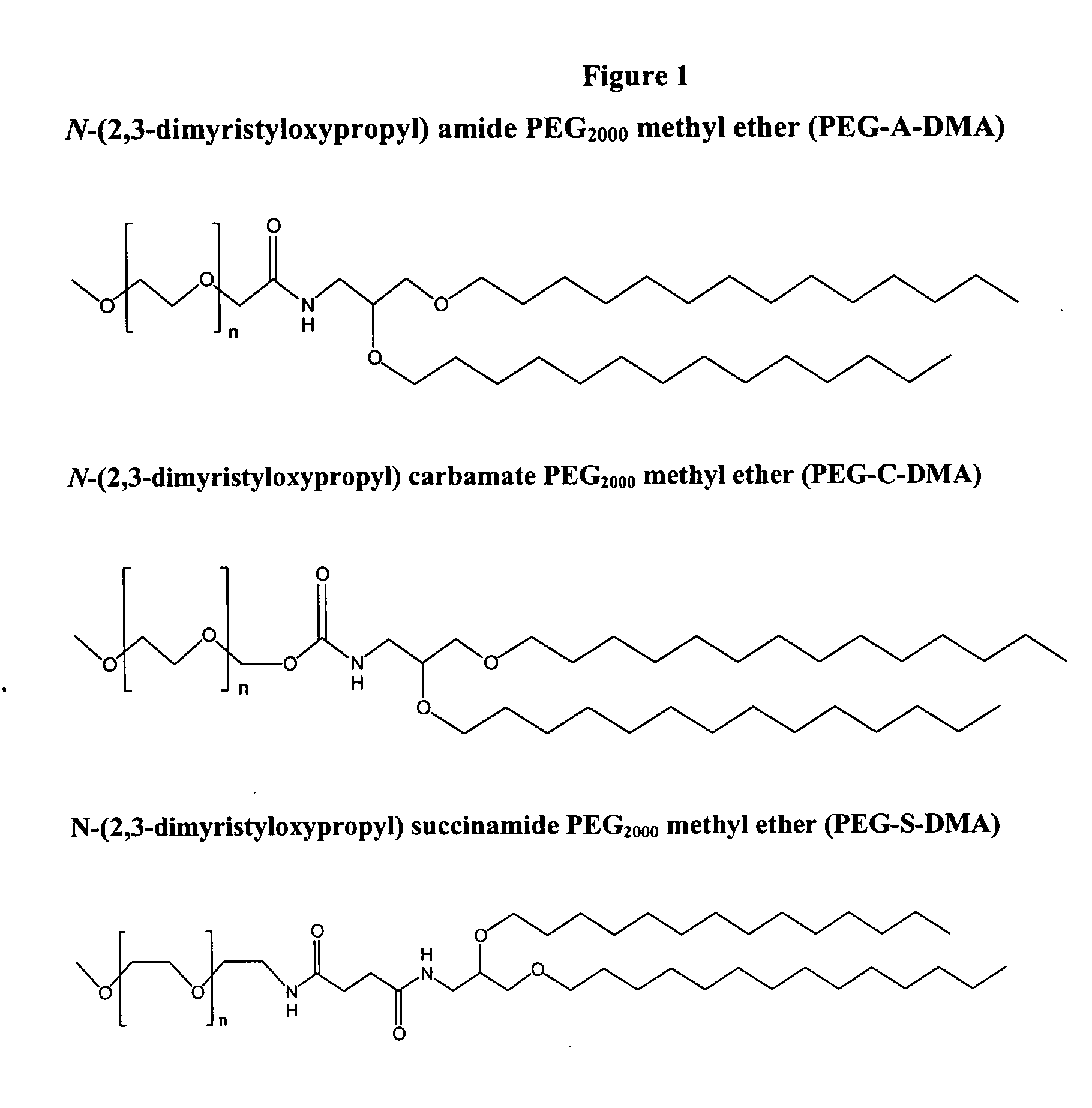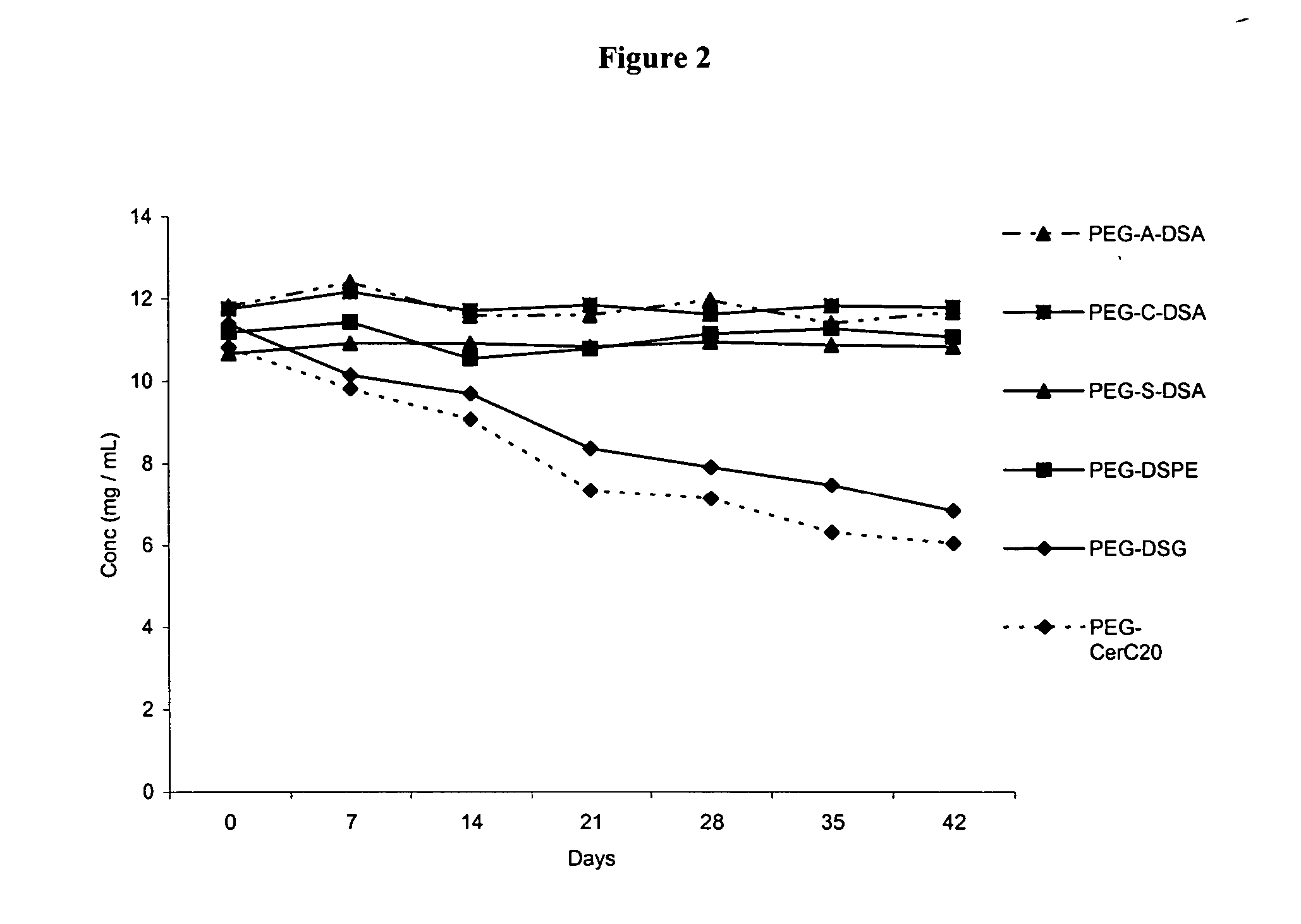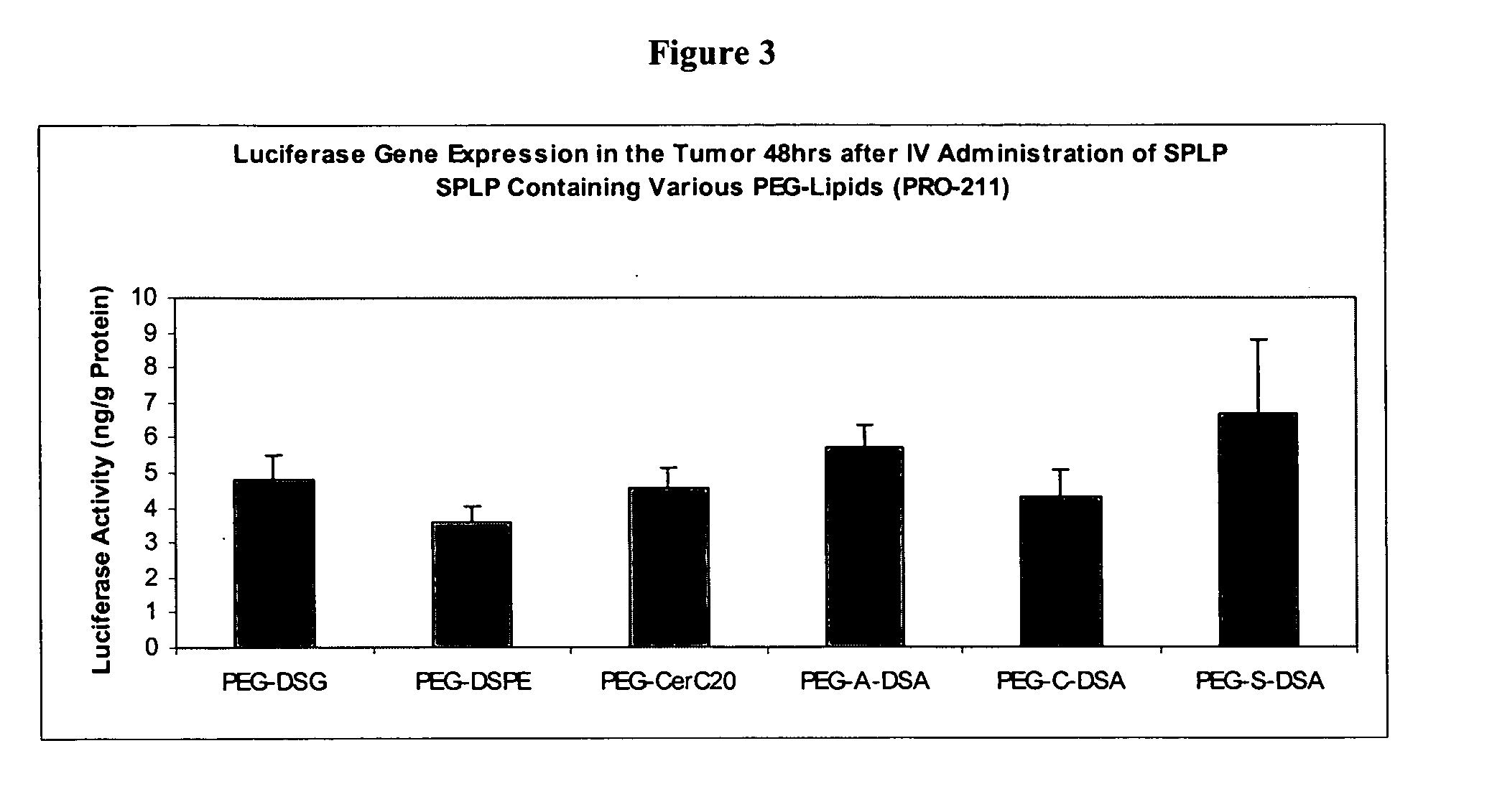Polyethyleneglycol-modified lipid compounds and uses thereof
a technology of polyethyleneglycol and lipid compounds, which is applied in the direction of drug compositions, genetic material ingredients, immunological disorders, etc., can solve the problems of large complexes, large potential reversion, and varied limitations, and achieve the effects of increasing the longevity or lifetime of the liposome, enhancing the properties of the liposome, and increasing the stability
- Summary
- Abstract
- Description
- Claims
- Application Information
AI Technical Summary
Benefits of technology
Problems solved by technology
Method used
Image
Examples
example 1
Synthesis of PEG-Dialkyloxypropyls (PEG-DAA's)
[0216] The following example illustrates the synthesis of three PEG-lipids, PEG-A-DMA (7), PEG-C-DMA (8), and PEG-S-DMA (9). They have a common precursor, the amine lipid 1,2-dimyristyloxypropylamine (5). This lipid has alkyl chains 14 carbon units (C14) in length. Other PEG DAAs suitable for use in the present invention can be synthesized using similar protocols. For instance, PEG-A-DSA and PEG-C-DSA can be synthesized by using the C18 analogue of (5). The C18 analogue can be synthesized by simply substituting an equimolar amount of stearyl bromide for myristyl bromide in the very first step (synthesis of compound (1)).
1. Preparation of 1,2-Dimyristyloxy-3-allyloxypropane (1)
[0217]
[0218] Benzene (250 ml) was added to 95% sodium hydride (11.4 g, 450.0 mmol), and the flask was flushed with nitrogen and sealed. A solution of 3-allyloxy-1,2-propanediol (6.6 g, 50.0 mmol) in benzene (75 ml) was added to the flask. Using a syringe, 97% 1-b...
example 2
Expression of Nucleic Acids Encapsulated in SPLP Comprising PEG-dialkyloxypropyl Conjugates
[0245] This example describes experiments comparing expression of nucleic acids encapsulated in SPLP comprising PEG-diacylglycerol conjugates versus SPLP comprising PEG-dialkyloxypropyl conjugates. All SPLP formulations comprise a plasmid encoding luiferase under the control of the CMV promoter (pLO55).
Time##after finalGroupMiceCellRouteTreatmentRouteDosesinjectionAssay*A6Neuro-2aSCPBSIV148 hrsBody weights,B6Neuro-2aSCSPLP PEG-IV148 hrsBlood analyses,DSGLuciferaseC6Neuro-2aSCSPLP PEG-IV148 hrsactivityDSPED6Neuro-2aSCSPLP PEG-IV148 hrsCeramideC20E6Neuro-2aSCSPLP PEG-A-IV148 hrsDSAF6Neuro-2aSCSPLP PEG-C-IV148 hrsDSAG6Neuro-2aSCSPLP PEG-S-IV148 hrsDSA
[0246] All SPLP formulations contained pL055 and DSPC:Chol:DODMA:PEG-Lipid (20:55:15:10). The following formulations were made:
No.SeedingInjectionCollectionGroupMicedateTreatmentdatedateA6Day 0PBSDay 13Day 15B6Day 0SPLP PEG-DSGDay 13Day 15C6Day ...
example 3
Expression of Nucleic Acids Encapsulated in SPLP Comprising PEG-dialkyloxypropyl Conjugates
[0250] This examples describes experiments comparing expression of nucleic acids encapsulated in SPLP comprising PEG-dialkyloxypropyl conjugates. All SPLP formulations comprise a plasmid encoding luiferase under the control of the CMV promoter (pLO55)
##GroupMiceTumorRouteTreatmentRouteDosesTimepointASSAY***A4Neuro-SCPBSIV148 hrsBody weights,2aBlood analyses,B5Neuro-SCSPLP PEG-DSGIV148 hrsLuciferase2aactivityC5Neuro-SCSPLP PEG-A-DSAIV148 hrs2aD5Neuro-SCSPLP PEG-A-DPAIV148 hrs2aE5Neuro-SCSPLP PEG-A-DMAIV148 hrs2a
[0251] The lipids (DSPC:CHOL:DODMA:PEG-Lipid) were present in the SPLP in the following molar ratios (20:55:15:10). The following formulations were made:
#SeedingInjectionCollectionGroupMicedateTreatmentdatedateA4Day 0PBSDay 12Day 14B5Day 0SPLP PEG-DSGDay 12Day 14C5Day 0SPLP PEG-A-DSADay 12Day 14D5Day 0SPLP PEG-A-DPADay 12Day 14E5Day 0SPLP PEG-A-DMADay 12Day 14
A: PBS sterile filtered...
PUM
| Property | Measurement | Unit |
|---|---|---|
| molecular weight | aaaaa | aaaaa |
| molecular weight | aaaaa | aaaaa |
| molecular weight | aaaaa | aaaaa |
Abstract
Description
Claims
Application Information
 Login to View More
Login to View More - R&D
- Intellectual Property
- Life Sciences
- Materials
- Tech Scout
- Unparalleled Data Quality
- Higher Quality Content
- 60% Fewer Hallucinations
Browse by: Latest US Patents, China's latest patents, Technical Efficacy Thesaurus, Application Domain, Technology Topic, Popular Technical Reports.
© 2025 PatSnap. All rights reserved.Legal|Privacy policy|Modern Slavery Act Transparency Statement|Sitemap|About US| Contact US: help@patsnap.com



